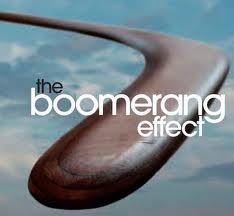Yeirang Lee
 This week I found a new interesting marketing communication method called “boomerang effect.” The boomerang effect is the social phenomenon that pushes a person towards anti-conformity (Bird, 2011). In other words, if a social marketing clause tries to strongly change the perception of someone, an equal force will counter that effort. This would then result in an attitude change away from the original effort given by the social marketing clause (Brehm, 1966).
This week I found a new interesting marketing communication method called “boomerang effect.” The boomerang effect is the social phenomenon that pushes a person towards anti-conformity (Bird, 2011). In other words, if a social marketing clause tries to strongly change the perception of someone, an equal force will counter that effort. This would then result in an attitude change away from the original effort given by the social marketing clause (Brehm, 1966).
If you still don’t get the concept, don’t worry. It took me a while as well, and it’s really simple once you get it. I’ll give you an example. For example, a group of college students campaigning to reduce alcohol consumption had an effect that increased alcohol consumption among their peers. What happened was that their peers read the campaign statement (The campaign stated that average college students spends $900 on alcohol per year) and realized that they were spending less on alcohol than the average person, so they spent more on alcohol and drank more to drink more than an average college student (Bird, 2011). Thus, the campaign created an opposite effect than the intended purpose.
Another interesting aspect about the boomerang effect is that it can relate with the “magnetic middle,” which is the force that attracts people towards the middle or average (Bird, 2011). So what happened with the alcohol campaign was that they were using social norms to influence the behavior of the students. This social norm provided a point of comparison for the students with the average. Thus those students who were above or below the average were attracted to the middle.
Although I explained the boomerang effect in a light manner, the dynamic relationship between agreement and confrontation is very complex. As I mentioned previously, there are two forces in persuasive communication – one that pushes towards positive change (directed by the communication) and one that resists the positive change. But the degree of force, incentives, language, and other factors implied in the persuasive communication can change the outcome of a boomerang effect (Mann & Hill, 1984). What movie theater marketers are doing now, for example, is that instead of stating “You MUST NOT litter,” they pinpoint signs where the trash can is located. This way, customers who feel as though they have the right to litter as part of the price paid for the ticket do not overtly react and feel that their freedom has been taken away as a customer (Mann & Hill, 1984).
Going back to the boomerang effect, there were also studies that showed there are ways to prevent the boomerang effect. There is what’s called “injunctive social norm” which is described as others’ approval of a particular behavior, and “descriptive social norm” which is the description of the norm, such as given by the alcohol campaign (Bird, 2011). For example, many organizations use injunctive social norms such as the community’s disapproval of littering, but also use descriptive social norms that just state that littering is present and the community should be aware of it to encourage picking up trash. But when both social norms are combined, it can have a powerful effect.
 One energy NGO campaigned to reduce energy consumption of the average person promoted four ways to reduce energy consumption: turning off unnecessary lights, taking shorter showers, turning off air conditioning, and using fans rather than air conditioning (descriptive social norms) (Bird, 2011). For those who did better than the average received a smiley face J on their front door, but those who did less than average received a frown L (injunctive social norm). The results showed that the households generally decreased the energy consumption, decreasing the boomerang effect (Bird, 2011).
One energy NGO campaigned to reduce energy consumption of the average person promoted four ways to reduce energy consumption: turning off unnecessary lights, taking shorter showers, turning off air conditioning, and using fans rather than air conditioning (descriptive social norms) (Bird, 2011). For those who did better than the average received a smiley face J on their front door, but those who did less than average received a frown L (injunctive social norm). The results showed that the households generally decreased the energy consumption, decreasing the boomerang effect (Bird, 2011).
It’s amazing how social norms can affect us in so many ways. This was a very interesting marketing method that utilized psychology of social norms and I feel as if it can be applied in so many ways. Simple ways include placing both injunctive and descriptive norms in marketing campaigns, billboards, and commercials to make people aware of the issue. Once people find the company to be powerful and persuasive in their act, organizations can have a strong impact on consumer behavior that could have dividend effects.
Bibliography
Bird, N. (2011). Boomerang effect: how you can take charge of your life. Bloomington, IN: iUniverse Inc.
Mann, F. & Hill, T. (1984). Persuasive Communications and the Boomerang Effect: Some Limiting Conditions to the Effectiveness of Positive Influence Attempts. In T. Kinnear, NA – Advances in Consumer Research (pp. 66-70). Provo, UT : Association for Consumer Research.
Brehm, J. (1966). A Theory of Psychological Reactance. New York: Academic Press.


2 Responses to The boomerang effect